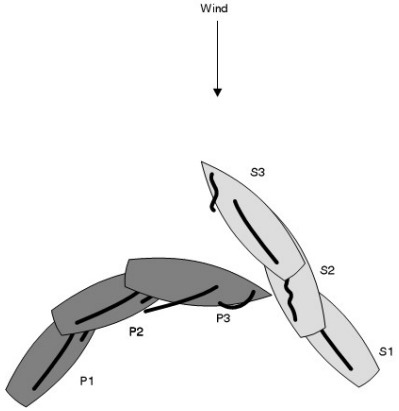S’s appeal is upheld. P is disqualified for breaking rule 10.
Rule 10 required P to ‘keep clear’ of S. ‘Keep clear’ means something more
than ‘avoid contact’; otherwise the rule would contain those or similar
words. Therefore, the fact that the boats did not collide does not necessarily
establish that P kept clear. The definition Keep Clear in combination with
the facts determines whether or not P complied with the rule. In this case,
the key question raised by the definition is whether S was able to ‘sail her
course with no need to take avoiding action’.
The following considerations lead to the conclusions that P failed to keep
clear of S and therefore broke rule 10:
-
the courses of the boats when the incident began. They were on
collision courses, which meant that at least one of them would have
to change course.
-
the distance between the boats at the moment both boats changed
their courses. After position 1, if neither boat had changed course, P’s
bow would have struck the leeward side of S after the boats had sailed
approximately two-thirds of a hull length.
-
the estimated time remaining before contact. When both boats
changed course there was very little time remaining before a collision
would have occurred. For example, at a speed of five knots one of
these boats would travel two-thirds of her length in 1.9 seconds. At
six knots it would be 1.5 seconds.
-
the extent of the course change needed by each boat to avoid a
collision. This increased as the boats came closer. At the time P
changed course, the change required was such that ‘with her tiller
turned as far to port as it would go’ she passed S’s stern ‘within two
feet’ (0.6 m). At the same moment, the course change S would have
needed to avoid P if P did not change course was approximately 90
degrees because S would have had to tack.
-
the time required by either boat to make the necessary course change.
This factor was itself determined by several others: the boat’s weight
and speed, her underwater hull shape, the size of her rudder, the sail
handling required, and wind and sea conditions.
When the boats reached position 1 in the diagram, P was not keeping clear.
A collision was imminent, and almost unavoidable, as shown by the fact
that with helm hard over P passed less than two feet (0.6 m) from S’s stern.
At that diagram position, S had no assurance that P had heard her hails, or
was preparing to change course, or even that P was aware of the presence of
S. Also, P had sailed beyond the point at which she should have borne off,
either to minimize the time and distance to reach the windward mark or to
sail a course chosen for tactical reasons. For all these reasons, S was clearly
unable to sail her course ‘with no need to take avoiding action’ and so P
broke rule 10. S was fully justified in expecting a collision and in concluding
that only her action would prevent it.
There is no need to address the question of whether or not S broke rule 16.1
or 16.2 because, by the time S changed course, P had already broken rule
10, and S, acting as required by rule 14, changed course to avoid a collision.
Even if the facts had indicated that S had broken rule 16.1 or 16.2, she would
have been exonerated by rule 43.1(a).
See also Case 50.
|
